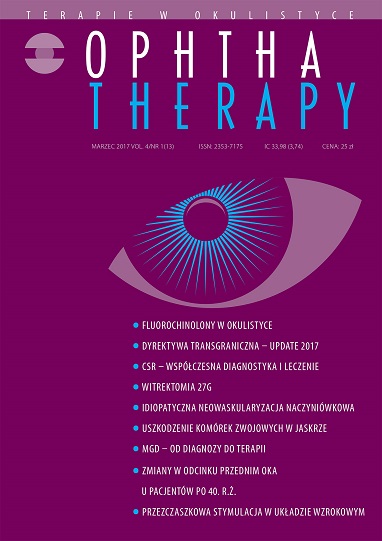Fluoroquinolones in ophthalmology – a voice in the discussion
Main Article Content
Abstract
Fluoroquinolones currently used in ophthalmology are effective in the treatment of bacterial infections of the anterior segment of the eye. The therapeutic effect is usually visible after 2–3 days of treatment, they are generally well tolerated by patients, and rarely cause allergic reactions. The choice of the right treatment of bacterial infections is not always simple and clear, even when we are sure of the presence of bacterial infection in a patient. There are the well-known factors that we take into consideration, when recommending the patient to be treated: the appearance of inflammation, the patient’s discomfort, the profile of action of the antibiotics involved, and the like. However, we also have to take into account the unknown factors: hypersensitivity to medicine ingredients, bacterial resistance to the antibiotic, and patient compliance.
Downloads
Article Details

This work is licensed under a Creative Commons Attribution-NonCommercial-NoDerivatives 4.0 International License.
Copyright: © Medical Education sp. z o.o. License allowing third parties to copy and redistribute the material in any medium or format and to remix, transform, and build upon the material, provided the original work is properly cited and states its license.
Address reprint requests to: Medical Education, Marcin Kuźma (marcin.kuzma@mededu.pl)
References
2. Hooper DC, Wolfson JS. The fluoroquinolones: pharmacology, clinical uses, and toxicities in humans. Antimicrob Agents Chemother. 1985; 28(5): 716-21.
3. Deschênes J, Blondeau J. Besifloxacin in the management of bacterial infections of the ocular surface. Can J Ophthalmol. 2015; 50(3): 184-91.
4. Park HS, Lee JH, Kim HK. Comparative clinical study of conjunctival toxicities of newer generation fluoroquinolones without the influence of preservatives. Int J Ophthalmol. 2015; 8(6): 1220-3.
5. Dowell SF, Schwartz B, Phillips WR. Appropriate use of antibiotics for URIs in children: Part II. Cough, pharyngitis and the common cold. The Pediatric URI Consensus Team. Am Fam Physician. 1998; 58(6): 1335-42, 45.
6. Cohen FL, Tartasky D. Microbial resistance to drug therapy: a review. Am J Infect Control. 1997; 25(1): 51-64.
7. Baquero F. Evolving resistance patterns of Streptococcus pneumoniae: a link with long-acting macrolide consumption? J Chemother. 1999; 11 Suppl 1: 35-43.
8. Scoper SV. Review of third-and fourth-generation fluoroquinolones in ophthalmology: in-vitro and in-vivo efficacy. Adv Ther. 2008; 25(10): 979-94.
9. Huz JI, Mukkamala K, Pagan IR, et al. Clinical outcomes and antibiotic susceptibilities of Staphylococcus aureus endophthalmitis. Graefes Arch Clin Exp Ophthalmol. 2016. https://doi.org/10.1007/s00417-016-3504-x.
10. Papa V, Blanco AR, Santocono M. Ocular flora and their antibiotic susceptibility in patients having cataract surgery in Italy. J Cataract Refract Surg. 2016; 42(9): 1312-7.

